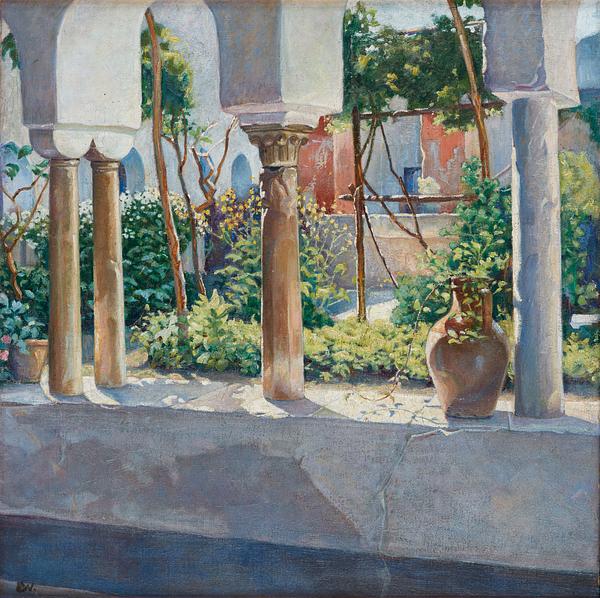Edvard Weie (1879–1943)
Cloister, 1907
Oil on canvas
49.5 x 49 cm
In the spring of 1907, Edvard Weie set out for Italy in the company of the painter Kristian Zahrtmann (1843–1917), who was his teacher at The Artists’ Independent Study Schools in Copenhagen from 1905 to 1907. In Rome, they saw works created by master artists of antiquity and the Renaissance, and in the smaller towns of Amalfi and Civita d’Antino they would paint local subjects, just as Zahrtmann and his pupils had been doing for many years.[1] During this trip, Weie created the light-filled image from the cloister of the Hotel Luna Convento in Amalfi – a former Franciscan monastery, founded in the thirteenth century, that had been converted into a hotel. The two artists took lodgings there in May 1907.
Weie has painted a view from the cloister corridor overlooking the courtyard with its verdant shrubs, trees and foliage. The point of view selected causes the eye to first be caught by and then pass beyond the various columns in the foreground, onwards into the warm light flooding the courtyard. Carefully observing the play between light and shadow, Weie has worked with a sparkling, warm palette. The result is an atmospheric composition, eloquently expressing the bright sunlight and bold colours of the south.
Cloister dates from the early days of Weie’s artistic work. It is a particularly strong testament to the influence exerted by his studies at The Artists’ Independent Study Schools and by Zahrtmann’s teaching at a time when, in 1907, Weie had not yet found his own voice. He did so in the decades that followed, focusing on mythological and literary subjects, employing a freer hand and working with an increasing richness of colour and luminosity rarely seen in Danish art at the time. Today, Weie is ranked among the most important Danish modernists – especially as regards the later period’s simplification of form and keen exploration of the timbre and expressive possibilities of colour.
Weie has painted a view from the cloister corridor overlooking the courtyard with its verdant shrubs, trees and foliage. The point of view selected causes the eye to first be caught by and then pass beyond the various columns in the foreground, onwards into the warm light flooding the courtyard. Carefully observing the play between light and shadow, Weie has worked with a sparkling, warm palette. The result is an atmospheric composition, eloquently expressing the bright sunlight and bold colours of the south.
Cloister dates from the early days of Weie’s artistic work. It is a particularly strong testament to the influence exerted by his studies at The Artists’ Independent Study Schools and by Zahrtmann’s teaching at a time when, in 1907, Weie had not yet found his own voice. He did so in the decades that followed, focusing on mythological and literary subjects, employing a freer hand and working with an increasing richness of colour and luminosity rarely seen in Danish art at the time. Today, Weie is ranked among the most important Danish modernists – especially as regards the later period’s simplification of form and keen exploration of the timbre and expressive possibilities of colour.
Inv. no. B 448
Published in:
Udstilling af maleren Edv. Weies arbejder : Kunstforeningen marts, København 1915, cat.no. 20, p. 4;
Grete Zahle: Dansk Kunst 1885-1915, Kunstforeningen, København 1976, cat.no. 127, p. 96;
Grete Zahle: Dansk Kunst 1885-1915, Kunstforeningen, København 1976, cat.no. 127, p. 96;
